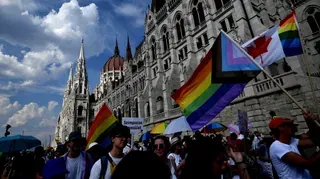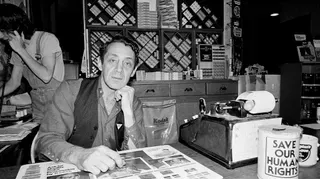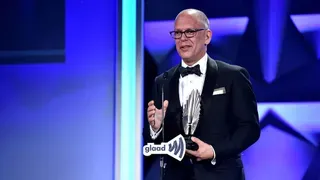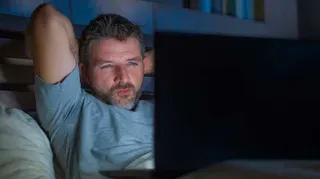October 8, 2020
Hard Lives Made Harder by COVID: Homeless Endure a 'Slow-Moving Train Wreck'
Anna Maria Berry-Jester READ TIME: 19 MIN.
The message wasn't lost on Daniel Gonzalez.
Early in the pandemic, one of the first things Imperial County did to ward off the virus was close the public bathrooms and, later, public cooling centers. In this sprawling Southern California desert, where summer brings blistering triple-digit heat, that lack of access could amount to a death sentence for people without shelter.
People like Gonzalez, homeless the past two years, were simply not a priority.
Months into the coronavirus shutdown, Gonzalez, 47, felt lonely. Calexico's quiet downtown had emptied out. July highs were topping 110, and it was uncomfortable wearing a mask in the swelter. But not having a place to rinse off or wash up, that was just a hazard.
Standing outside a closed restroom in Calexico's Border Friendship Park, looking out over the complex of metal bars and security equipment that marks the U.S.-Mexico border, he waited for dinner. Every night at 7:30 p.m., volunteers assembled at the park to serve a hot meal to anyone in need. A few weeks before, pressured by the organizers, the county started dropping off hand-washing stations right before the meal, only to whisk them away as soon as it was served.
Gonzalez lined up. At least it was something.
This was supposed to be the year that California finally did something about its epidemic of homelessness. On February 19, Gov. Gavin Newsom stood before lawmakers in the state Capitol, and delivered an unprecedented State of the State address devoted entirely to the homelessness crisis. California is home to one-quarter of the nation's homeless population, a grim distinction painfully visible not only on city sidewalks, but also along the state's freeways and farm levees, in its urban parks and suburban strip malls.
Past administrations had mostly ignored the problem, Newsom said, but he'd be different. "It's a disgrace that the richest state in the richest nation – succeeding across so many sectors – is falling so far behind to properly house, heal and humanely treat so many of its own people," he told the crowd.
But even as Newsom spoke, a different epidemic was advancing silently across the state. Exactly one month later, he would order a far-reaching statewide shutdown, asking every person in California not working in an essential industry to shelter at home in an effort to stave off COVID-19.
It was a complicated ask for the more than 150,000 Californians without a home.
For two weeks in March, Newsom's top homelessness adviser, Jason Elliott, gathered with academics, service providers and county representatives at the emergency operations center just outside Sacramento to confront the menace that COVID-19 presented for tens of thousands of people living outside, often without access to clean water or basic hygiene. They pored over data showing how California's homeless population had gotten larger, older and sicker in recent years. More than 40% of homeless Californians are age 65 or older or have underlying health conditions such as heart disease, according to the state's internal estimates – factors that put them at greater risk of infection and death from COVID-19.
"When you take the attack rate and apply it to more than 100,000 unsheltered people," Elliott said, "you very quickly find out that tens of thousands of homeless people are potentially susceptible to dying of coronavirus."
They would need to act quickly. The crowded shelters, in short supply and usually considered safe ground for homeless people, suddenly posed a risk of transmission and would have to be thinned out. Instead, the very conditions lambasted as California's shameful legacy of neglect – people subsisting in makeshift shanties and battered tents in parks and alleys and freeway underpasses – emerged as a safer alternative. The federal Centers for Disease Control and Prevention advised that people sleeping outside should be left alone; the encampments that pre-pandemic were routinely dismantled would be largely left in place, state officials decided.
But California still would need somewhere to house people considered most at risk: those who are older and have chronic health conditions. His plan wasn't ready for prime time, but Newsom had been quietly pursuing an ambitious idea to buy up hotel and motel rooms to get people off the streets and into housing with supportive services. Now, with the declaration of a state and national emergency, it looked as if the Federal Emergency Management Agency might help pay to rent them temporarily. Newsom set a goal of 15,000 rooms.
In the months since, the state's efforts to shelter homeless residents amid COVID-19 have played out in starkly contrasting storylines, bent and molded by local politics and resources. The state and federal governments have pledged millions for Project Roomkey, the state's signature public health effort to move the most vulnerable into housing, with local counties expected to foot a quarter of the bill, as well as arrange meals, security and support services. For now, the counties taking part are fronting all the funding and say they have no idea when they'll be reimbursed.
Still, most counties are participating and have procured nearly 16,500 rooms, according to state data, housing 22,300 people at various times since March. And homeless services providers, particularly in the state's urban centers, say the unprecedented promise of funds has allowed them to work small miracles, linking desperate people to social services, health care and sometimes jobs.
But if the hotel rooms have been lifesaving for those lucky enough to get inside, providers across the state also were forceful in noting they are reaching just a sliver of those in need. In some cases, hotel owners have been unwilling to participate in Project Roomkey, while elsewhere city and county leaders have been hesitant or flat-out opposed.
In the meantime, the prolonged closure of shelters, churches and charities – along with the restaurants and retailers that offer access to electricity, water and food – has made life far more brutal for the tens of thousands of homeless people who weren't selected for a room. In many counties, the life hacks and cobbled-together supports that homeless people rely on for survival have disintegrated. The squalid encampments have only gotten larger, fueled by COVID-spurred prison and jail releases and an unprecedented economic shutdown that community leaders say has landed scores more people on the streets.
If the state's goal was to ward off a deadly COVID-19 outbreak among the homeless, it can claim success. Quick work to thin out the shelters has so far prevented widespread homeless deaths from the virus, authorities say.
But suffering comes in other forms. And interviews with dozens of homeless people, activists and local officials in 12 counties reveal a new magnitude of hardship and indignity for California's homeless – and no easy answers ahead. What follows are a few of their stories.
Imperial County
"I'm one of the ones that it would probably kill me quick if I got that virus. I'm just staying away from everyone." – Carl Wilkinson, 60, El Centro
Carl Wilkinson had been living for several weeks on a stretch of dirt beside a plowed field in sight of the lone indoor mall in El Centro. Wilkinson has chronic obstructive pulmonary disease and probably qualifies for a COVID hotel room through Project Roomkey. But he lost his ID a while back, so he hasn't even tried applying.
Wilkinson has no idea how he'll get an ID; money is tighter than usual because the recycling centers, where he takes the cans and bottles he collects, have closed. He's become so desperate that he has resorted to panhandling, though that hasn't gone well either, since so many people are staying inside. "It's all-around tougher," he said.
In May, the only men's shelter in Imperial County closed temporarily after seven of the 20 men staying there caught the coronavirus. Though the shelter spaced beds farther apart and hung plastic dividers, men say they are afraid to return. The Salvation Army, which typically offers meals and a place to shower, has closed several times as staffers have fallen ill.
Instead, Wilkinson has been bathing in the dingy waters of the irrigation ditch next to his tent.
He knew about the federal guidelines saying people are safer from the virus if they can stay in one place. That had given him and two neighbors some hope there would be at least one silver lining to the pandemic: not getting rousted by cops. But the sheriff had shown up the day before saying they had to pack up. He wasn't sure where they'd go. "They move us around like cattle in a pasture when it's grazed," Wilkinson said.
Imperial County, which hugs the border with Mexico, is a desert valley transformed into an agricultural hub nearly a century ago by water diverted from the Colorado River. The county of 181,000 people has an official homeless count of 1,527, including several hundred people who live off the grid in a remote area known as Slab City. Imperial has the highest death rate from COVID-19 of any county in California.
The largest city in the county is El Centro, home to one of the county's two hospitals, and, until its church leaders were arrested last year, a ministry the FBI accused of luring homeless people into forced labor. Though the homeless population has steadily grown in the past few years, the county has little in the way of services for the homeless.
Sgt. James Thompson of the El Centro Police Department and Anna Garcia, a code enforcement officer, serve as the lone homeless outreach team for the city but are limited in what they can do. "A lot of people are confused about my role," Thompson said. "We have not gotten into the homeless business; it's an effort to curb the quality-of-life issues." The pair know many of the people who are homeless in El Centro by name. They know who gets in trouble with the law, who has an issue with drug use and who has a mental illness.
Before COVID-19, Thompson had a daily routine. Get in at 8, hit the streets to talk to people who are homeless. He'd move them, make sure they weren't getting into trouble, offer help when he could. Then in June, a colleague on the force got into a physical altercation with a homeless man, contracted COVID-19 and died. Thompson's chief has been a lot more cautious with his officers in the weeks since.
Before their work was curbed, Thompson and Garcia helped several people fill out paperwork for a hotel room. None got in. "They met the criteria, they did do what they were supposed to do. But for whatever reason, there was no funding when it was time for them to be placed," Garcia said. She feels it fits a pattern of services going to those who are easiest to help, whether it's families or people who just can't make rent. People who chronically live on the streets are not the easiest to help.
In August, months into the pandemic, county officials had 36 hotel rooms to work with, and had placed 274 homeless people in rooms or trailers at some point. Among them were 27 people who had COVID-19, although there were almost certainly more since the county isn't routinely testing homeless groups.
And the El Centro officers say they worry there's been a spike in other types of deaths. Three people died of overdoses over three days in the same dusty parking lot this summer, said Thompson. One was a young woman who'd experienced years of family abuse. They had been working to get her off the streets. He'd thought she was doing better.
Twenty minutes south, Maribel Padilla has organized the nightly feeding program in Border Friendship Park since 2015. She's seen how the closing of fast-food restaurants and local businesses have made it harder for the people she helps. When the county closed the public bathrooms early in the pandemic, the folks her Brown Bag Coalition feeds no longer had a place to wash their hands.
It took a protracted battle and her loud mouth to change that, Padilla said. County officials told her they were concerned the virus would spread through hand-washing stations, a concern that makes Padilla spew profanities.
"They've been out there and exposed to so much shit," Padilla said. Thousands go back-and-forth between Mexico and the U.S. each day; farmworkers cram into crowded buses to get to work; elderly and homeless residents travel together via public transportation.
"It's going everywhere," she fumed "and you're worried about the soap dispenser?"
Alameda County
"Due to the number of deaths especially in the African American community, I have reasonable concern of the likelihood of harm and injury, possibly death." – Andre Alberty, 53, Oakland, in a grievance filed with the California Department of Corrections and Rehabilitation
Andre Alberty was born and raised in Oakland, like his parents. Except for the years he spent in prison, it has always been home. When he returned to the neighborhood after an early release from San Quentin, a maximum-security prison in one of the wealthiest counties in the country, he was blown away by the number of RVs, tents and live-in cars lining the streets. It was a striking testament to housing costs that had soared out of reach. "There needs to be more affordable housing for people," he said. "I never saw it like this."
Alberty's most recent prison stint was for burglary. He contracted COVID-19 in San Quentin after the California Department of Corrections and Rehabilitation moved dozens of inmates to the Bay Area prison from the California Institute for Men in Chino while it was in the midst of a major coronavirus outbreak. "What makes you think it's not going to come in here when it went around the world in four months?" he remembers thinking. "You don't think it's going to jump a hallway?"
When Alberty, 53, and his cellmate developed symptoms, they knew that telling the guards would get them thrown into solitary, a place usually used as punishment that has been turned into a de facto medical isolation wing. And so, for several weeks in June and July, he was alone in "the hole," with nothing but his thoughts and a virus to keep him company. By the end of September, COVID-19 had killed 28 inmates at San Quentin and infected 2,241 others, as well as 290 staff members.
It was demoralizing, to be infected and confined in solitary as a result. "Psychologically, that affects you," Alberty said. "You feel like you ain't nobody. Then how do you expect us to come out here and try to make ourselves somebody?"
That's where his mind was in mid-July when his sentence was cut short, part of a massive early-release program Newsom ordered as COVID-19 carved a deadly swath through the state's 35 prisons. Since then, Alberty has alternated between staying on a sick friend's couch and in a friend's RV, part of a large community of locals camping along Mandela Parkway in the heart of West Oakland because they've been priced out.
Prison releases are just one of the ways the homeless population has grown since the pandemic began. Californians have experienced unprecedented job loss, with the unemployment rate at 13%. A moratorium on evictions has helped millions stay in their homes, but the protections are loosely enforced and many tenants aren't aware of their rights. Others were kicked out of the homes of family and friends who weren't eager to have someone sleeping on the couch or floor in the middle of a pandemic.
"This is a slow-moving train wreck on a scale that we have never seen," said Dr. Anthony Iton, senior vice president for healthy communities at the California Endowment.
To Alberty's south, in East Oakland, Megan Ruskofsky-Zuccato, 25, was living under an overhead rail line in an old RV with her partner and a friend. Though she'd been homeless on and off, they had a place when the pandemic hit – until April, when, without explanation, the landlord asked them to move out. "I wish I would have known that Gov. Gavin Newsom put that [eviction moratorium] in effect, because then I would have never left," she said.
Her partner got the RV as a trade for unpaid work as a welder at the start of the pandemic. She finds the whole situation humiliating. "When you live out here, people just look at you like you're a bad person," she said.
Jennifer Friedenbach is executive director of the Coalition on Homelessness in San Francisco, which advocates for housing and social justice in the city. On a daily basis, she sees both the opportunity – and nightmare – of the pandemic response. She is thrilled nearly 3,000 people in San Francisco had a hotel to sleep in at some point during the pandemic. And that San Francisco has put out more portable hand-washing stations and bathrooms.
The problem is, there's not nearly enough to go around. Not enough rooms, not enough sanitation, not enough enforcement of tenant protections, not enough places to charge a phone. The number of tenants calling an anti-eviction hotline has doubled to 200 a week since 2019, and Friedenbach thinks more should have been done for rental assistance. Vehicles are often a first stop for people when they lose their homes, she said, and she's seeing a lot more people sleeping in cars.
And while homeless people aren't dying from COVID-19 in the numbers once feared, they are dying nonetheless. Deaths among the homeless tripled in San Francisco in the early months of the pandemic. In Los Angeles County, homeless deaths were up 27% over 2019.
Friedenbach worries that's about to get worse. "Everything is coming to a screeching halt; the placement in hotels is halted," she said. "Things are going to start getting really bad again in terms of a lot of people being out on the streets."
Fresno County
"It's hard times and we are suffering. My voices are getting stronger and stronger." – Juan Gallardo, 53, Selma
Luciana Lopez sat in the back seat of a van rumbling across rutted roads in the rural outskirts southeast of Fresno. Her eyes scanned the dusty expanse of orchards and vineyards looking for the telltale hollows. Her attention was tuned to a bitter reality in this breadbasket-feeding-a-nation: the dozens of people living underground in the farm fields, subsisting in burrows hand-dug into the ground and irrigation levees – where they can hide from the sun, immigration authorities, violence, judgment.
Just days before, after local landowners complained, law enforcement had descended on this encampment, known casually as "The Hole," and rousted an estimated 60 people from their dirt caves, many of them seniors. Outreach workers said maybe two landed in a shelter. The rest, a mix of addicts, itinerant farmhands and those with a run of bad luck, had dispersed to god-knows-where.
For Lopez, who works as an outreach worker for a homeless services provider that contracts with Fresno County, it was yet another COVID setback. Whatever trust had been built, whatever efforts underway to connect these men and women with ID cards, food stamps, disability payments, medical services – the chances of follow-through had largely evaporated.
Nearly five months into the pandemic, finding housing for Fresno County's homeless seemed an insurmountable challenge. A January count pegged the homeless population of Fresno and Madera counties at more than 3,600, a 45% rise from 2019. Even in non-COVID times, this region of mega-farms and meatpacking plants had relatively little to offer in terms of government-sponsored shelters and supportive housing outside the city of Fresno. Instead, social workers looked to the relatively cheap housing stock as a solution, using federal and state funds to rent apartments for their clients.
But COVID has changed the real estate arithmetic. Local providers say large numbers of middle-income residents have lost jobs in the state's months-long shutdown and are relocating to less expensive rentals. The units once available for $600 or $800 a month – and affordable for someone living on government assistance – are disappearing amid pitched demand.
Hotel and motel operators in Fresno County have not enthusiastically embraced Project Roomkey. Under the program, the county is sparingly using just one hotel to house homeless people infected with COVID-19. Drawing on other state and federal funds, the county managed to rent out two additional hotels, open to anyone who is homeless and vulnerable, in Selma and the nearby town of Sanger. As of late September, all 82 rooms were filled, with waiting lists stretching dozens long. Vacancies at four other converted sites, with about 350 beds, are quickly filled.
"It's heartbreaking, we go through the breakdowns with them, we go through all the frustrations to get them ready for housing, just for the freaking system to spit them out and say there's nothing for you," Lopez said.
Her crew had resorted to basics, driving the farm roads southeast of the city to distribute water, snacks and masks to people living in ragtag encampments amid bountiful acres of fruit and nuts. They did so not knowing who might be carrying the virus, because there has been so little testing.
Juan Gallardo, 53, was on one of Lopez's stops on a muggy morning in mid-July. Homeless most of his life, Gallardo had set up camp under suspended tarps on a dirt field just below the Golden State Highway near Selma. When the stores and churches shut down, he was cut off from the critical supports he'd developed for a life on the streets: odd jobs; gathering cans and bottles for recycling. There was nowhere close by to charge a phone or buy groceries, no access to clean water. He had taken to bathing in a nearby drainage canal, though it triggered rashes. For drinking water, he'd haul back a couple of pails for boiling.
"It's hard to get food on your table right now, you have to hustle even more," Gallardo said, as he rinsed clothes in a bucket. "It's hard being in the crisis; you never know who can have [the virus]. But I try not to think about it, because the more you think about it, you start getting worried and then you stop doing what you're supposed to be doing."
Gallardo, who has untreated bipolar disorder and arthritis in both his knees, said he had lost access to medication and it was getting harder to cope. "My voices are getting stronger," he said.
About a mile away, in downtown Selma, Delfina Vazquez said the pandemic has exposed a whole new level of desperation in her county. Vazquez heads Selma Community Outreach Ministries, a charity run out of a converted storefront that launched a daily food pantry at the start of the pandemic. As other local charities shuttered, she said, "We knew people would still need to eat. We looked to the Lord, who said, 'Open your doors.'"
What started as a hot midday meal expanded into a food delivery service to families in a circle of farm towns, from Selma to Reedley to Parlier and Orange Cove. Vazquez said her ministry, funded primarily by donations and government contracts, is now providing 10,000 meals a month, mostly to homeless people and farmworker families struggling amid the shutdown. "People are becoming homeless because of COVID," she said. "It's absolutely growing."
Through her ministry, Vazquez also oversees a Super 8 in Selma and Townhouse Motel in Sanger that have been converted to COVID shelters for the homeless. All 30 rooms at the Super 8 are full, she said, providing housing for 14 families, including 30 children. The waitlist stands at 60.
Like many advocates working with the homeless amid COVID-19, she worries about what will happen when the state and federal emergency funding wind down at year's end. If the newly converted hotels close down, she said, "that's 81 families out on the street." And where would they go? The real estate offices "don't want to flat-out say we don't want to rent" to homeless people, she said, so instead have started demanding that applicants earn three times the rent to qualify.
Vazquez is already working on a Phase Two: talking with local officials about raising money to buy land in Selma where they could build a community of tiny homes. "Realistically, no one wants to rent to someone evicted," she said. "There's no second chance here. That's where we're at right now."
Los Angeles
"He was really afraid of finding out what his true identity was, but we assured him he's staying here no matter what. We're not kicking him out." – Dr. Coley King, speaking about Charles Poindexter, 71, Santa Monica
For people who did get indoors during the pandemic, the rooms have, in many cases, been life-changing.
Dr. Coley King, a physician with the Venice Family Clinic and director of homeless services, practices "street medicine," bringing health care directly to people on the street. His patients have complex histories, and it's rare that he gets clear signs their health is improving. But during the pandemic, it's happened several times after patients have received housing. One patient with uncontrolled diabetes started having normal blood sugar readings. One of his "super users," who makes regular visits to the emergency room, hadn't been to a hospital in months. And multiple clients with addiction issues were getting sober.
Then there was, perhaps, the most dramatic case, involving the tall, sturdy man he'd seen on the streets of Santa Monica over the years. The man had previously confided in King that he wasn't sure who he was, and the doctor noted signs of memory loss. In June, the street medicine team found him a space in a Santa Monica hotel. It took just a few days to find a diagnosis for his cognitive issues: untreated syphilis and a traumatic brain injury from a bus accident.
They also found his name: Charles Poindexter.
"He's telling me, 'I don't know if I did something wrong out there, and I don't know if I want to know who I am,'" King said. "It turned out good because he's not wanted by the law anywhere, and we're all good."
These stories can be found across the state. In Fresno, Cammie Bethel, 37, could bring her six children back to live with her after getting into transitional housing. Cornelio Mendoza, 52, who in December became homeless for the first time, was able to get sober after getting a city-sanctioned tent in Santa Rosa. "Being here, I'm grateful," he said.
Seeing the transformation that can happen when someone has a safe place to sleep makes it all the more tragic how limited resources are, advocates say.
Across the state, counties have marshaled thousands of rooms and safe camping sites for hundreds of tents. The state gave counties more than 1,300 trailers to isolate people infected with or exposed to COVID-19. Still, lack of interest from hotel owners and opposition from neighbors have blunted the program's reach. That's true also in Los Angeles, which set its own goal of renting 15,000 rooms and fell far short.
In L.A., rooms are not evenly distributed across the sprawling county. Less-affluent areas like South Los Angeles, a historically Black neighborhood that's now predominantly Latino and experiencing high rates of COVID-19, have few hotels available. Whiter, wealthier cities like Santa Monica, meanwhile, have bolstered the county supply by renting hotels with their own budgets.
In Bakersfield, neighbors and a hospital pushed back on two different plans to rent motel rooms. Kern County, where Bakersfield is located, has not made available any new hotel rooms to the homeless during the pandemic.
And officials in liberal cities – including on Newsom's home turf of San Francisco – say the governor must do more to persuade business owners and financiers to participate in housing the homeless.
"I'm surprised and honestly a bit disappointed that the state hasn't been more forceful and proactive to secure the adequate number of hotel rooms," said San Francisco Supervisor Matt Haney, whose district includes the Tenderloin, a neighborhood where hundreds of people sleep on sidewalks and in alleys. "I would like to see more leadership from the governor on some larger negotiated statewide solution with hotels and unions."
The hotel rooms weren't meant for everyone unsheltered, said Kim Johnson, director of the California Department of Social Services. For those who didn't have mental and physical health conditions that put them at extreme risk, "the right environment wasn't necessarily a hotel room," she said.
Newsom said he is staying the course on his vow to make this the year California finally starts tackling its epidemic of homelessness. In some ways, the pandemic gave him a leg up – he would have been hard-pressed to find even temporary housing for the 22,300 people moved into hotels and motels in recent months.
But it's also a short-term response to a long-term public health crisis. To battle homelessness, the state needs more housing.
Counties across the state say they are already winding down Project Roomkey. The state has launched a new program called "Project Homekey," which will allocate an estimated $800 million in federal and state emergency funding to cities and counties to purchase hotels and motels, vacant apartment buildings and other structures, then convert them into supportive housing. So far the state has approved $450 million worth of projects in 34 jurisdictions, stretching from El Centro to Ukiah. If successful, they'd open more than 3,300 housing units – a valiant effort but a fraction of what experts say is needed.
Newsom has acknowledged the extraordinary task ahead but said solving homelessness in the age of COVID-19 remains his priority.
"We need a permanent response," Newsom said at a recent news conference. "I can assure you, we are just winding up."
Subscribe to KHN's free Morning Briefing.







